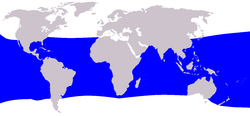Bryde's Whale
|
|
| Bryde's Whales Conservation status: Unknown | ||||||||||||||||||
|---|---|---|---|---|---|---|---|---|---|---|---|---|---|---|---|---|---|---|
| Missing image Brydes-whale.jpg | ||||||||||||||||||
| Scientific classification | ||||||||||||||||||
| ||||||||||||||||||
| Binomial name | ||||||||||||||||||
| Balaenoptera brydei | ||||||||||||||||||
| Binomial name | ||||||||||||||||||
| Balaenoptera edeni | ||||||||||||||||||
 Bryde's Whale range |
Bryde’s Whales are the least-known and in many ways the most unusual of the rorquals. They are small by rorqual standards—no more than about 25 tonnes—prefer tropical and temperate waters to the polar seas that other whales in their family frequent; are largely coastal rather than pelagic, and although they retain the characteristic plates of whalebone that the baleen whales use to sieve small creatures from the waters with, their diet is composed almost entirely of fish.
There appear to be two species, and some confusion between them exists. Bryde's Whales are very similar in appearance to Sei Whales and almost as large, and were not described until 1878 from a stranded specimen on the coast of Burma, which was given the name Balaenoptera edeni. In 1913 whales off the coast of South Africa were described as Balaenoptera brydei, the name being given to honour Johan Bryde, Norwegian consul and pioneer of the South African whaling industry. (Note that "Bryde's" is pronounced "broo-dess".)
By the 1950s, it was thought that they were a single species, which became B. edeni (because the first proposed name for any species always has priority) but retained Bryde's Whale as the common name. Recent genetic work, however, indicates that there are in fact two separate species:
- Bryde’s Whale, Balaenoptera brydei, with a worldwide tropical and semi-tropical distribution, grows to 26 tonnes and 15 metres long.
- The Pygmy Bryde's Whale (still often called Eden's Whale, Balaenoptera edeni), is found in coastal waters of the eastern Indian and western Pacific oceans.
Bryde's whales vary considerably in form. Five different types have been identified, including at least two smaller ones that tend to stay closer inshore. Alas from the point of view of taxonomic simplicity, DNA testing shows that the newly confirmed pygmy species of South-east Asia is not the same as the similar-looking small form found in the Caribbean. Complicating matters still further, there are forms which appear to be intermediate between Bryde's Whale and the Sei Whale.
In general, Bryde's Whales have a very broad and short head, with between 40 and 70 ventral grooves, and relatively large eyes. They can be recognised by the 3 parallel longitudinal ridges on the head, from the tip of the snout back to the blowhole. (The other rorquals have just one ridge.) They have a single 3 to 4 metre vertical blow. The prominently curved, pointed dorsal fin is readily seen when a Bryde's Whale surfaces. The flippers are small and slender; the broad, centrally notched tail flukes never break the surface.
Colour varies: the back is generally dark grey or blue to black, the ventral area a lighter cream, shading to greyish purple on the belly. Some have a number of whitish-grey spots, which may be scars from parasites or shark attacks.de:Brydewal nl:Bryde-walvis
